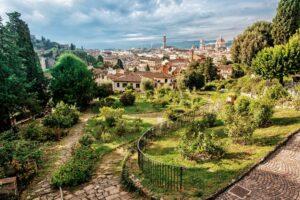Fodor's Expert Review Piazza della Signoria
Here, in 1497 and in 1498, the famous "bonfire of the vanities" took place, when the fanatical Dominican friar Savonarola induced his followers to hurl their worldly goods into the flames. It was also here, a year later, that he was hanged as a heretic and, ironically, burned. A plaque in the piazza pavement marks the spot of his execution.
Cellini's famous bronze Perseus, shown holding the severed head of Medusa, is among the most important sculptures in the Loggia dei Lanzi. Also noteworthy are The Rape of the Sabine Women and Hercules and the Centaur, both late-16th-century works by Giambologna (1529–1608). But it's the Neptune Fountain, created between 1550 and 1575 by Bartolomeo Ammannati, that dominates the square. The Florentines call it "il Biancone," which may be translated as "the big white man" or "the big white lump." Giambologna's equestrian statue, to the left of the fountain, portrays Grand Duke Cosimo I. Occupying the steps of the Palazzo... READ MORE
Here, in 1497 and in 1498, the famous "bonfire of the vanities" took place, when the fanatical Dominican friar Savonarola induced his followers to hurl their worldly goods into the flames. It was also here, a year later, that he was hanged as a heretic and, ironically, burned. A plaque in the piazza pavement marks the spot of his execution.
Cellini's famous bronze Perseus, shown holding the severed head of Medusa, is among the most important sculptures in the Loggia dei Lanzi. Also noteworthy are The Rape of the Sabine Women and Hercules and the Centaur, both late-16th-century works by Giambologna (1529–1608). But it's the Neptune Fountain, created between 1550 and 1575 by Bartolomeo Ammannati, that dominates the square. The Florentines call it "il Biancone," which may be translated as "the big white man" or "the big white lump." Giambologna's equestrian statue, to the left of the fountain, portrays Grand Duke Cosimo I. Occupying the steps of the Palazzo Vecchio is a copy of Michelangelo's David, as well as Baccio Bandinelli's Hercules.
READ LESS







